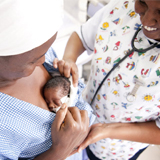
Exclusive breastfeeding for the first six months is the most beneficial way to feed all babies; if the mother is HIV-positive, breastfeeding should be accompanied by antiretroviral treatment.
When HIV-positive mothers stop breastfeeding, they should do so gradually over a period of one month. If the mother is HIV-negative she should ideally continue breastfeeding until the baby is two years old, with complementary foods added from six months. Babies who are HIV-positive should ideally also be breastfed for two years.
From the age of six months breast milk alone is no longer sufficient to meet a baby’s nutritional needs. Age-appropriate, safe and nutritionally adequate complementary foods and liquids should, therefore, be given in addition to breast milk1. When the baby is between the ages of 6-8 months, complementary foods should initially be given 2-3 times a day. These guidelines are from the National Department of Health Clinical Guidelines for PMTCT (Prevention of Mother-to-Child Transmission) 2010ii.
Exclusive breastfeeding contributes to building healthy babies and children, and ensures that babies do not get sick as it strengthens their immune system and protects them against death from illnesses such as diarrhoea and pneumonia. These benefits are also true in areas where HIV prevalence is high and the risks of transmission through breast milk are taken into account.